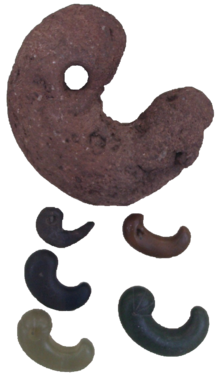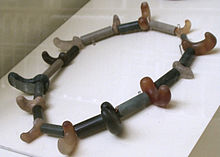- Magatama
-
Magatama (勾玉 or 曲玉), are curved beads which first appeared in Japan during the Jōmon period.
They are often found inhumed in mounded tumulus graves as offerings to deities (see grave goods). They continued to be popular with the ruling elites throughout the Kofun Period of Japan, and are often romanticised as indicative of the Yamato Dynasty of Japan. They are mainly made of jade (翡翠), agate (瑪瑙), quartz (石英), talc (滑石), and jasper (碧玉).[1] Some consider them to be an Imperial symbol, although in fact ownership was widespread throughout all the chieftainships of Kofun Period Japan. It is believed that magatama were popularly worn as jewels for decoration, in addition to their religious meanings. In this latter regard they were later largely replaced by Buddhist prayer beads in the Nara period.
In modern Japan, the magatama's shape of a sphere with a flowing tail is a common visual representation of the human spirit (hitodama).[citation needed]
Contents
Yasakani no Magatama
The most important magatama is the Yasakani no Magatama (八尺瓊曲玉, also 八坂瓊曲玉), which is part of the Imperial Regalia of Japan, added some time around the Heian period. The Yasakani no Magatama stands for benevolence, and is one of the three items used in the ceremony of imperial ascension. In Japanese mythology, the jewels, along with the mirror, were hung on the tree outside of Amaterasu's cave (where she had hidden) to lure her out. It is believed to be a necklace composed of jade magatama stones instead of a solitary gem as depicted in popular culture. It is believed to be enshrined in Tokyo, in the Japanese Imperial Palace.
Origins
The consensus among Japanese archaeologists is that magatama originated in Jōmon Japan before spreading to the Asian continent through the Korean peninsula. It is claimed that the earliest Korean prehistoric magatama date to the Early Mumun (post-850 BC) and are generally found in the southern part of peninsula in proximity to Japan.[2][3][4] Charles Keally, an archaeologist based in Japan who has conducted research on magatama, states:
"The magatama's origins are more controversial. These curved jewels of jadeite are common in Kofun Period burials, and they are common also in Korean sites of the same age. But magatama are found in Yayoi sites, too, and unquestionable true magatama are reported also in Jomon sites in Tohoku, Japan as early as about 1000 B.C., long before true magatama appeared in Korea."[4]
The magatama is also found on early Korean (presumably before/after AD 660) royal gold crowns before Mongols came to the Korean peninsula and has long been considered a sign of royalty in Korea as well as being a connection with Shamanistic elements. However the production distinct of magatama is not found from archeology site in Korea yet.
See also
References
- ^ The Japanese Enthronement Ceremonies By Daniel Clarence Holtom, Sophia University, 1972, and other books regarding Magatama.
- ^ magatama - Britannica Online Encyclopedia
- ^ Bulletin No.27
- ^ a b Kofun Culture
Japanese mythology Mythic texts Kojiki | Nihon Shoki | Fudoki | Kujiki | Kogo Shūi | Hotsuma Tsutae | Nihon Ryōiki | Konjaku Monogatarishū | Shintōshū

Japanese creation myth Takamagahara mythology Izumo mythology Yamata no Orochi | Hare of Inaba | ŌkuninushiHyuga mythology Human age Emperor Jimmu | Tagishimimi | Kesshi HachidaiMythical locations Major Buddhist figures Amida Nyorai | Daruma | Five Wisdom BuddhasSeven Lucky Gods Shinto deities | Japanese deities | Sacred objects | Japanese religions Categories:- Japanese monarchy
- State ritual and ceremonies
- Beadwork
- Jōmon period
- Hardstone carving
Wikimedia Foundation. 2010.


